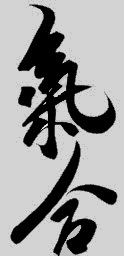"Coaching The SKU Way!" Official SKU Coaching Resource
First Published February 2012 Issue 46 SKU Quarterly Magazine
KIAI; Spiritual Meeting / Battle Cry.
by Derick Kirkham

Sadly, kiai has by
some been reduced to a mere throat generated shout, which is
accompanied by an
aggressive action. The legitimate usages of kiai are wide and varied,
but it
does seem that nowadays, the list of usage has been extended to
incorporate,
the cajoling of Shinpan (referees) into awarding the shouting athlete a
dubious
point. This oiling of the squeaky wheel, is not because the technique
that they
have delivered was an effective one, nor that it had displayed
great kime,
but it’s merely because the athlete has expressed the desire to be
awarded a
point, for something that is in their own opinion , "worth a point".
Unscrupulously they express their desire through a loud, elongated and
bizarre sounding
shout. It is something that they believe resembles a genuine kiai.
Sometimes
this cosmetic and exceedingly annoying warble comes in the form of a
multi note
high pitched screech. This unflattering imitation of a kiai is achieved
by a
strange vibrato action of the larynx. This is more an over
inflated
display of self worth and it comes from a misplaced point of origin,
and therefore,
it sounds nothing like a genuine healthy kiai; however, it does sound
remarkably
much more like Clouseau’s side-kick, Kato, and it clearly says a lot
more about
the ego of the athlete, more than it does about their humility or the
focused
success of their delivered technique. Nevertheless, here are some other
uses of
kiai; (to startle, to momentarily break the concentration of an
opponent, to intimidate,
to express confidence, to express anticipated success, in creating an
opening, to
control the exhalation of breath, as an expression of the correct
martial
spirit).
Some Karate texts, especially kata books use a symbol to denote the appropriate place in which to kiai, while others display a word that is phonetically produced to aid the reader in attaining the correct pronunciation. However, many of these books were written by people who speak English as a second language, and the copy that you may have read could well have been translated into English and other languages much later. Unfortunately, pronunciation therefore, may differ slightly dependant upon the mother tongue of the translator and this can create errors by giving the wrong impression of how to pronounce a kiai to a foreign reader whose first language is different than that of the author or the translator.
This is a generic list, that is dependant upon where the performer places their emphasis during the initial or later stages of the kiai, and whether or not the performer makes a final abdominal squeeze during the production of the kiai; they will dramatically alter the tonal quality of the kiai; and often the performers intonation is heard as a slight deviation of the generic form; or as a the tapering off of the intensity of the blast of air from the lungs at the later stages of the kiai. It is often heard as an entirely different note. Nevertheless, they are accepted as being of the same generic root, and that is why they have been included in the examples below.
Male example 1
Female example 1
Male example 2
Female example 2
Female example 3 "variation of end note"
Eeeee! should be
pronounced as a
strangulated & elongated version of the letters ‘ee’ as heard
in the word ‘meet’.
Example 1
Example 2
Hiiii!
should
be
pronounced as an elongated version of the letters ‘hi’ as heard in the
word ‘high’.
Arrrgh! should be pronounced as an elongated version of the letters ‘ar’ as heard in the word ‘arrow’
.Having read this article, don't
feel too down
hearted if your kiai doesn't match those of the quoted expert examples,
or if by
now, your kiai has started to sound rather feeble or silly. Because you
can
hear from the examples that, even the worlds most recognised experts do
vary. But
there is a common denominator, a constant that they share, and that is
that
they are all using the sounds that are based around the generic list,
to
generate their convincing and effective kiai. Another thing to consider
is that
even the same performer sometimes fluctuates from using one kiai in
favour of
another. This fluctuation can even be heard by certain performers
during their performance
within a single kata. The reason for this could be because, kiai is an
emotionally stimulated conditioned reflex of a response, and as such,
can
differ in sound from time to time; dependant upon the performers
emotional
state and their level of focused commitment at
that precise
moment.
